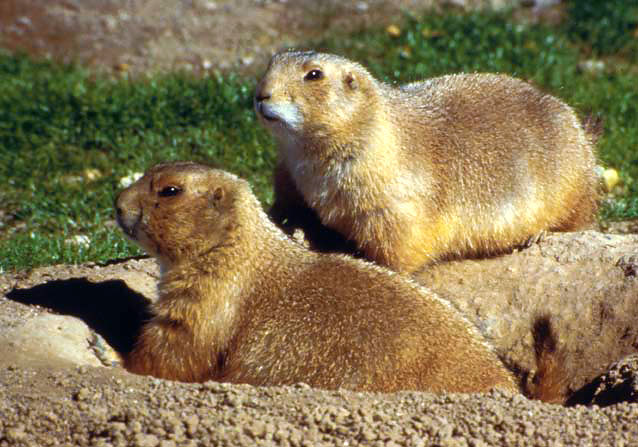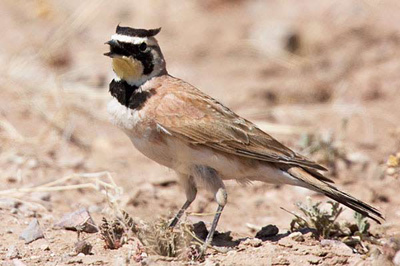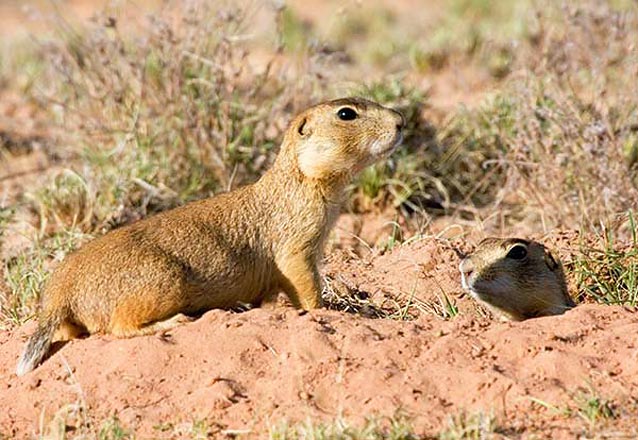There are five species of prairie dogs—the black-tailed prairie dog (Cynomys ludovicianus), white-tailed prairie dog (Cynomys leucurus), Gunnison’s prairie dog (Cynomys gunnisoni), Utah prairie dog (Cynomys parvidens), and Mexican prairie dog (Cynomys mexicanus)—all of which may be considered rare (Hoogland 2006a). After 200 years of shootings, poisonings, conversion of habitat, and more recently plague, prairie dog numbers are a fraction of what they once were. Two of the species (Utah and Mexican) are listed as threatened or endangered under the Endangered Species Act (ESA). The black-tailed and whitetailed prairie dogs are currently under review by the U.S. Fish and Wildlife Service (USFWS) to determine whether the species might warrant protection under the ESA. In 2008, the USFWS determined that some populations of the Gunnison’s prairie dog are a candidate for listing.

© Ron Singer
The black-tailed prairie dog, the most abundant, widespread, and conspicuous of the species, generally occurs east of the other prairie dogs and occupies about 26-27 km2 (6600-6900 ac) of land managed by the National Park Service (NPS) in the western U.S. (USFWS 2004; Sidle et al. 2006). Because this is the most abundant/widespread prairie dog species in the American Southwest, it is the focus of this series. However, the Gunnison’s prairie dog also occurs in the Southwest and is discussed.

© Robert Shantz
Although their consideration as a keystone species is controversial, the prairie dog has a pronounced impact on its ecosystem (Kotliar et al. 2006). Prairie dogs increase habitat diversity and contribute to grassland ecosystem processes. Prairie dogs clip the vegetation and maintain open habitats preferred by some animals (e.g., such as the horned lark [Eremophila alpestris] and mountain plover [Charadrius montanus]). Many species, such as American badgers (Taxidea taxus), prairie rattlesnakes (Crotalus viridis), burrowing owls (Athene cunicularia), and the federally endangered black-footed ferret (Mustela nigripes), prey on prairie dogs or use their burrows for shelter.
Physical Description
Prairie dogs have small ears, relatively large black eyes, a short tail, and muscular legs. They are recognized as falling into two subgroups, with the black-tailed and Mexican prairie dogs in one group, and the remaining three species, including the Gunnison’s, in the other group. A physical difference between the two subgroups is that black-tailed and Mexican prairie dogs have black-tipped tails that are long (5-7.5 cm, 2-3 inches), while the other species have white- or gray-tipped tails that are shorter (2.5-5 cm, 1-2 inches) (Hoogland 2006a). Another difference that is noticeable at colony sites is that black-tailed and Mexican prairie dogs do not hibernate, in contrast to the other species which stay underground for about four months during late fall and winter.
The black-tailed prairie dog is so named because of its characteristic, black-tipped tail. The species is approximately 35-43 cm (14-17 in) long and weighs 0.45-1.36 kg (1-3 lbs). The black-tailed prairie dog’s fur is buff-colored and it often blends with the color of the soil. Male prairie dogs are larger than females, except perhaps for females in late pregnancy (Hoogland 2006b). For prairie dogs that survive their first year, males often live 2-3 years (and up to 5) and females often live 4-5 years (and up to 8).

© Robert Shantz
The Gunnison’s prairie dog is about 30-38 cm (12-15 in) long and weighs between 0.6 and 1.1 kg (1.4 and 2.6 lbs) (USFWS 2008), with males usually larger than females. Their coloring is yellowish buff with blackish hairs intermixed. Noticeably darker in color are the tops of their heads, sides of cheeks, and eyebrows. The species varies from other species in its group by having hairs in the tip of its tail that are grayish-white instead of pure white.
As important as a description of the prairie dog itself, is that of its colony site. Colony sites may extend for miles and contain hundreds of mounds that surround the burrow entrances. Black-tailed prairie dog mounds may be as high as 0.76 m (2.5 ft), with a diameter up to 2.1 m (7 ft) (Hoogland 2006c). Because black-tailed prairie dogs eat or clip grasses and other plants that grow taller than about 30 cm (12 in), vegetation at colony sites is relatively short. In contrast, within colonies of Gunnison’s prairie dogs, shrubs are often more than 51 cm (20 in) tall (Hoogland 2006a).
Prepared by Patricia Valentine-Darby, Southern Plains Network Inventory and Monitoring Program, 2009.
Part of a series of articles titled Prairie Dogs of the American Southwest.
Last updated: May 19, 2015
